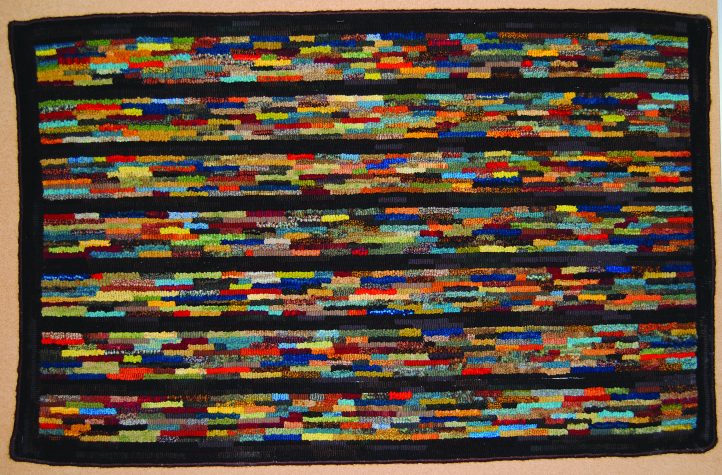
Thrift, 32″ x 50″, varying cuts of wool on linen. Designed and hooked by Melinda Russell, Morgantown, West Virginia, 2007.
TEXT AND PHOTOGRAPHY BY MELINDA RUSSELL
Multistrip hooking is a technique in which I pull two, three, or four skinny strips of wool through the fabric foundation at once to form one lovely loop. One of the strips almost inevitably twists, and we all know that rug hooking orthodoxy dictates we keep our strips flat as we pull them.
As I see it, however, a twisted strip expands rug hooking possibilities by lending texture to the piece.
Inspiration for a New Technique
When my rug hooking mentor, Dorothy Moffett, was near the end of her life, she offered to sell me her hand-dyed and off-the-bolt wools, her mountains of #2-cut and #3-cut stripettes, her unhooked and half-hooked patterns, and her collection of Cushing dyes, dyeing pots, dye formula notebooks, and other dyeing equipment she had collected. Of course, I accepted.
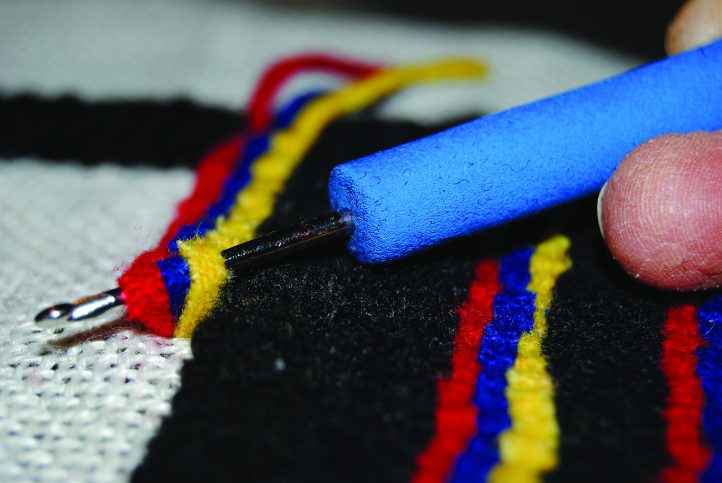
Multistrip hooking is the technique of pulling two, three, or four strips of wool at the same time through one hole of the backing.
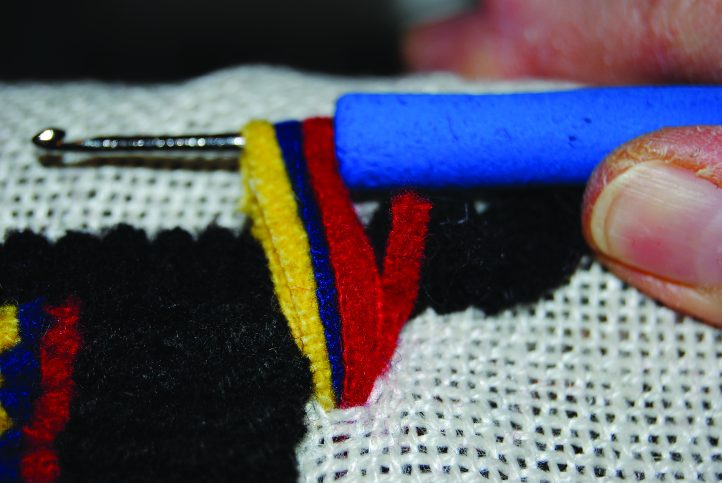
Another view of the multistrip technique using the Abby Vakay hook.
Seeking order from my happy chaos of inherited stripettes, I spent an afternoon on the laundry room floor, separating single strands and bundles of strips into three huge piles: pastels; strong winter colors
(true reds, forest greens, navy blues, and blacks); and browns, oranges, golds, chartreuses.
With everything in order, I felt obligated to hook up those mountains of strips; Dorothy had dyed or collected them at rug camps, and I had paid her good money for them. But I was not a fine-cut hooker, and hooking them into a hit-or-miss piece that used the entire color wheel did not appeal to me.
My solution evolved in stages. It started with a unique hooking tool designed by Abby Vakay that featured a head large enough to grasp nontraditional materials such as rib-bons, silky fabrics, and even hanks of horse hair. Now I could grab two, three, or four of Dorothy’s #2- and
#3- cut strips and pull them through a linen or monk’s cloth foundation at the same time. My discovery is a sim-ple variation on the traditional rug hooker’s technique of pulling one strip of wool through a fabric foundation.
A Rug Called Thrift
My first rug incorporated both traditional and multistrip techniques. The brown bands of the rug are individually pulled #9 strips; I kept the loops even with no twisting. Between each long brown band, I hooked nine hit-and-miss rows of essentially #9 colorful strips. Sometimes I hooked a single #9 strip. When that strip ran out, I continued with three #3-cut strips. When those strips ran out, I continued with two #4-cut strips or four #2-cut strips. The idea was to make each vertical row approximately the width of one #9 strip of wool. The brown bands served two purposes: they corralled the strips into a fairly uniform vertical space and they quieted down the riot of color going on in the hit-and-miss skinny bands.

Detail of Thrift. Multistrip hooking uses two, three, or four strips of wool as one, in any given color segment.
Teacher Sandra Brown made two invaluable suggestions at her monthly drop-in meeting. While I had intended to run the bands vertically, Sandra pointed out that running them horizontally would mean less waste, and given the rug’s name, I took that to heart. So I simply hooked any given strip or bundle of strips until it ran out and then continued hooking in the long vertical direction.
Shortly after I started the rug using two rows of #9 wool in the long brown bands, Sandra suggested that a wider brown band would make a stronger impact. Pulling out the previously worked loops was worth the effort because the colorful bands look better confined within strong brown borders.
Multistrip Hooking in a Pictorial: Hawk’s Nest
My husband’s great-grandparents once owned land in West Virginia, in the terrain I depicted in my rug, Hawk’s Nest. Searching a database of online photos in the West Virginia and Regional History Collection, I looked for any photo with “Hawk’s Nest” in the name. I purchased a photo and a digital file, advised the Collection that I intended to replicate the view in a hooked piece, and consented to crediting my source material.
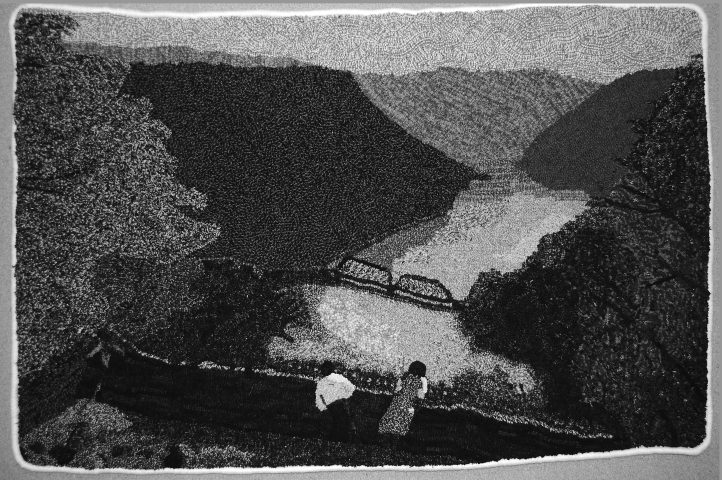
Hawk’s Nest, 25″ x 38″, various cuts of wool on linen. Adapted from a photograph in the West Virginia and Regional History Collection and hooked by Melinda Russell, Morgantown, West Virginia, 2009.
When I held the photo in my hand, I realized that the color palette for my rug was set: I would hook a black-and-white Hawk’s Nest. I analyzed the digital photo file with Paint by Numbers 2005™ software and transferred the photo to my fabric backing. I then shopped for shades of black and gray wool in tweeds, checks, and solids.
My multistrip hooking helped greatly with one problem in this rug: the depiction of leaves on trees in the distance. Leaves reflect differing amounts of sunlight, shimmering and fluttering. Capturing that variation was a challenge. So sometimes I paired a #4 dark gray strip with a #2 lighter gray strip and pulled them together through one hole. I curved the line for two, three, or four loops, and then cut the strips short. Beginning where I left off, I then pulled one #6 dark gray strip and meandered that strip as I pulled three or four more loops. For this section I usually pulled two strips at a time, always using different shades of gray and sometimes using different cuts. My goal was to achieve a dappled sunlight effect.
Pinnacle, a PRIMCO Pattern Designed by Fritz Mitnick
I sorted my strippettes again, this time into one basket full of nothing but wonderful greens, another basket full of blues, and so on. This past summer I spotted my basket of yellow and gold stripettes and thought yellow would be a pleasant color to work with during warm weather. I overdyed my yellows and golds to ensure even more harmony among them.
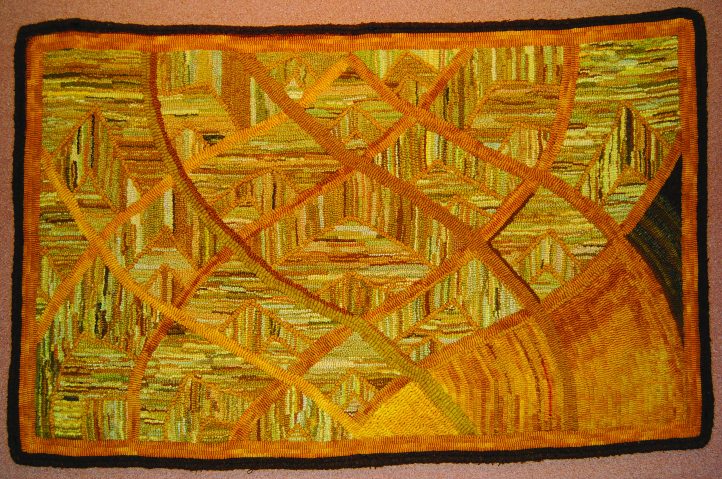
Pinnacle, 28″ x 45″, varying cuts of wool and wool yarn on linen. Pattern by Primco (# PR1409); modified and hooked by Melinda Russell, Morgantown, West Virginia, 2009.
Many of my stripettes have been dyed and dyed again, so they are fuzzy and irregular, skinny in some places, fat in others. Since my willingness to hook these orphan stripettes is motivated by a use-it-up, make-it-work (jerry-rigging) attitude; I am not bothered by their irregularity. However, after several trips through the dye bath, many of my strips were very short, calling for annoyingly frequent stops and starts. It took motivation (or obsession) not to chuck those mountains of short strips. But I think that obsession with thrift served the finished rug well. The short bursts of color scattered across Pinnacle, while not easy to work with, distinguish the rug from traditionally beautiful ones.
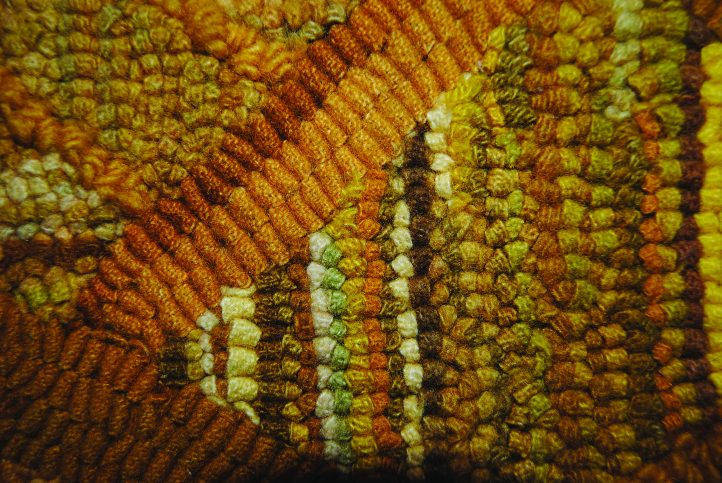
Detail of Pinnacle, showing the effect that can be achieved by using multistrip hooking.
While working on Pinnacle, I realized I did not have enough of my skinny stripettes to finish the rug. I ended up placing light gold at the bottom center moving up to dark gold on the right side of the rug. Is that color riff still another instance of jerry-rigging?
Maybe. If so, rug hooking, with its endless need for problem solving and improvisation stretches my expertise and, in the process, fills my days with quiet joy.
